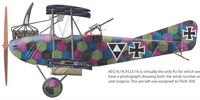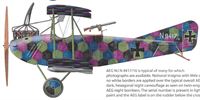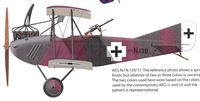
| Самолеты (сортировка по:) | |||||
| Страна | Конструктор | Название | Год | Фото | Текст |
AEG N.I / C.IV N

|
Страна: Германия Год: 1917
|
| AEG - J.I / J.II - 1917 - Германия | <– | –> | AEG - DJ I - 1918 - Германия |
 |
J.Herris - AEG Aircraft of WWI /Centennial Perspective/ (16) |
| AEG C.1042/16 may have been the AEG C.IVn/N.I prototype. It was sprayed in a two-color camouflage, probably in the typical green and mauve shown here. |
 |
J.Herris - AEG Aircraft of WWI /Centennial Perspective/ (16) |
| AEG N.I N.9323/16 is virtually the only N.I for which we have a photograph showing both the serial number and a unit insignia. This aircraft was assigned to FA(A) 209. |
 |
J.Herris - AEG Aircraft of WWI /Centennial Perspective/ (16) |
| AEG N.I N.9389/16. The reference photo shows a sprayed finish that appears to be in two colors. The two colors used here were based on the colors used by the AEG J.I and J.II that were contemporary with the N.I. |
 |
J.Herris - AEG Aircraft of WWI /Centennial Perspective/ (16) |
| AEG N.I N.9417/16 is typical of many for which photographs are available. National insignia with little or no white borders are applied over the typical overall AEG dark, hexagonal night camouflage as seen on twin-engine AEG night bombers. The serial number is present in light paint and the AEG label is on the rudder below the cross. |
 |
J.Herris - Development of German Warplanes in WWI /Centennial Perspective/ (1) |
| A typical AEG N.I in standard AEG factory finish for night bombers. The national insignia are barely visible. Powered by the 150 hp Benz Bz.III, it carried six 50kg bombs are under the wings. This bomb load, substantially more than its ancestor the AEG C.IV could carry, was made possible by the larger, longer-span wing. Production was limited because both Idflieg and the crewmen preferred the AEG G.IV and other twin-engine bombers. |
 |
J.Herris - AEG Aircraft of WWI /Centennial Perspective/ (16) |
| AEG N.I N.139/17.The reference photo shows a sprayed finish, but whether of two or three colors is uncertain. The two colors used here were based on the colors used by the contemporary AEG J.I and J.II and the pattern is representational. |
 |
J.Herris - AEG Aircraft of WWI /Centennial Perspective/ (16) |
| AEG C.IV C.1042/16 with typical AEG sprayed camouflage is probably the prototype C.IVn because C.1042/16 is a normal C.IV number. This aircraft appears to lack the characteristic over-wing bracing used on C.IVn/N.I production aircraft and retains the 160 hp Mercedes D.III from the C.IV. Three 50 kg P.u.W. bombs are visible under the port lower wing. |
 |
O.Thetford, P.Gray - German Aircraft of the First World War /Putnam/ |
| The AEG N.I was a long-span version of the AEG C.IV modified to carry more bombs, and this view clearly shows the key N.I recognition features. First, the N.I had a long wing with 3-bay bracing compared to the shorter, 2-bay wings of the C.IV. Next, the triangular bracing truss above the upper wing center section was required to strengthen the longer N.I wing against bending so it could pass the required load test. Unlike its daylight predecessor the AEG C.IV, the N.I did not have a fixed machine gun for the pilot; the observer's gun was thought sufficient for both strafing and defending the aircraft at night. The high exhaust stack directed the noise and flames away from the aircraft, which was important to maintain the pilot's night vision.Typical AEG sprayed camouflage on the upper surfaces is evident. |
 |
A.Imrie - German Bombers /Arms & Armour/ |
| The good results achieved by C class two-seaters at night led to the development of night bombing versions with increased wing area and capable of carrying heavy loads on short-range operations. Although the AEG N 1 was slow and took 50 minutes to reach an altitude of 1,800m, it was capable of very short take-off and landing runs and could carry six 50kg P.u.W. bombs on its wing racks. Note external additional span-wise bracing on the top wing centre-section, the exhaust pipe extension flame-damper and landing lights in the top wing leading edge. Thirty-seven machines of this type were with the front-line units at the end of February 1918, but the ever-improving performance of the twin-engined G types caused further experiments with the N category to be abandoned in May 1918. |
 |
J.Herris - AEG Aircraft of WWI /Centennial Perspective/ (16) |
| A unit portrait was taken in front of this AEG N.I; unfortunately, no further details are known. The landing lights in the leading edge of the upper wings are clearly visible. |
 |
J.Herris - Nachtflugzeug! German N-types of WWI /Centennial Perspective/ (3) |
| This view shows the N.I's characteristic triangular bracing trusses above the upper wing center section. The trusses strengthened both wing spars to handle the increased bending forces of the longer wing. Multicolor, hexagonal camouflage similar to that used by the AEG twin-engine night bombers was applied to many N.I aircraft. Given that the N.I shared the same operational role, it is not surprising that similar camouflage was used. "Franz" and "Emil" look less than enthused about their next night bombing mission. A Wolff propeller is fitted to this N.I. |
 |
J.Herris - AEG Aircraft of WWI /Centennial Perspective/ (16) |
| This view shows the N.I's characteristic triangular bracing trusses above the upper wing center section. The trusses strengthened both wing spars to handle the increased bending forces of the longer wing. Multicolor, hexagonal camouflage similar to that used by the AEG twin-engine night bombers was applied to many N.I aircraft. Given that the N.I shared the same operational role, it is not surprising that similar camouflage was used. Few N-types were built; crews preferred the larger G-types for night bombing. |
 |
J.Herris - AEG Aircraft of WWI /Centennial Perspective/ (16) |
| AEG N.I N.9323/16 carries air-droppable supply containers under its wings; the parachutes are wrapped around the front of the wicker containers. One of the few N.I bombers seen in unit markings, it is assigned to FA(A) 209. The night bomber hexagonal camouflage shows the wear from operational flying. A Wolff propeller is fitted, and the landing light in the leading edge of the upper left wing is visible. |
 |
J.Herris - AEG Aircraft of WWI /Centennial Perspective/ (16) |
| AEG N.I N.9389/16 (possibly N.9399/16; the next to last digit is partly obscured) wears the two-color sprayed camouflage scheme and has lasted long enough for Balkan crosses to replace the original iron cross insignia. Wooden wheels are fitted due to the scarcity of rubber, and the landing light in the leading edge of the upper left wing is visible. The wood wheels indicate this machine may have been in training service when the photo was taken. |
 |
J.Herris - AEG Aircraft of WWI /Centennial Perspective/ (16) |
| The versatile AEG C.IV was developed into the AEG N.I night bomber by enlarging its wingspan and fitting three bays of struts to support it. This rear view shows the two key AEG N.I recognition features; the long, 3-bay wing and the triangular braces for both front and rear spars above the center section. The hexagonal night camouflage typical for these aircraft is evident. |
 |
J.Herris - AEG Aircraft of WWI /Centennial Perspective/ (16) |
| Two AEG N.I bombers are seen in in this photo of FA(A) 209. The aircraft on the far right in the row nearest the camera is a Rumpler C.IV; to its left in the row nearest the camera are two AEG N.I night bombers. |
 |
J.Herris - AEG Aircraft of WWI /Centennial Perspective/ (16) |
| AEG N.I 139/17, the only known photograph of an N.I from the second production series, shows the extended cabane section and the cowling panels that fold back to expose the engine for maintenance. This photograph was taken at the Bavarian training base in Lechfeld, and the aircraft is fitted with a 180 hp Argus As.III engine. National insignia is in the late style and the camouflage was sprayed on in two colors. |
 |
J.Herris - Nachtflugzeug! German N-types of WWI /Centennial Perspective/ (3) |
| Some AEG N.Is were used briefly in a civilian capacity after the war. Civil N.I aircraft may have been given the 200 hp Benz Bz.IV engine, which could account for the different shape of the engine cowling and over-wing radiator. The wing structure appears to be modified. |
 |
J.Herris - AEG Aircraft of WWI /Centennial Perspective/ (16) |
| Two AEG N.I bombers wearing the hexagonal camouflage scheme have collided on the ground. N.9417/16 is nearest the camera and has the letters 'AEG' in a rectangle on the lower rudder. |
 |
J.Herris - Nachtflugzeug! German N-types of WWI /Centennial Perspective/ (3) |
| Crash of an unknown AEG C.IVn/N.I showing the night camouflage and upper-wing bracing. The night bomber camouflage is so dark it is hard to see the national insignia. The two trusses bracing the upper wing spars are prominent. |
 |
J.Herris - Nachtflugzeug! German N-types of WWI /Centennial Perspective/ (3) |
 |
J.Herris - AEG Aircraft of WWI /Centennial Perspective/ (16) |
| Plan view of AEG N.I in typical AEG hexagonal night bomber finish. |
 |
J.Herris - Nachtflugzeug! German N-types of WWI /Centennial Perspective/ (3) |
| AEG N.I |
 |
J.Herris - Nachtflugzeug! German N-types of WWI /Centennial Perspective/ (3) |
| AEG N.I |
 |
J.Herris - Nachtflugzeug! German N-types of WWI /Centennial Perspective/ (3) |
| AEG N.I |